Corleone: On the trail of The Godfather
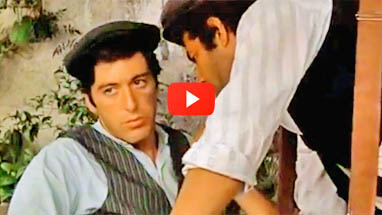
At a glance Corleone is like many villages in Sicily: picturesque, serene, peaceful. So why do tourists go out of their way to visit Corleone while on holiday? The town's famous name draws them to the warm little village. In "The Godfather", Corleone is the place the Godfather was born and the surname adopted by the fictional mafia family.
And this is no accident: in the years after the Second World War, Corleone actually was a stronghold of the Sicilian Mafia and considered for a time to be one of the most dangerous cities in the world.
Today, though, peace has broken out in Corleone in an almost boring way. If it weren't for cafe owners advertising with images from "The Godfather", all traces of the Mafia would be "sleeping with the fishes" - at least for those enjoying their holiday in Sicily. But those who live in contemporary Corleone year-round know that the theme of "mafia" still has some presence – today, however, it's in the form of local and regional anti-mafia coalitions.
Author
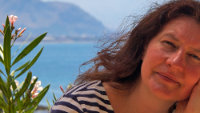
The information on this site comes from our Sicily expert Britta Bohn.
Britta has been dealing with daily life and life in Sicily for over 20 years.
Don't miss any of her tips! Subscribe to our free Newsletter:
An Invitation
Dear friends of Sicily, we invite you to join the Facebook Group "Trip-Tipp Sicily". Find answers to all your questions and discover exclusive tips for your trip to Sicily from those who have already made the journey and those who already know the island from the inside out:
Content
- Map Sightseeing Tour of Corleone
- City Center
- The Waterfall
- Ficuzza Nature Reserve
- Madonna di Tagliavia Pilgrimage Church
- Borgo Schirò - Mussolini's ghost town
- The Godfathers
- Find your ideal Holiday Letting
Holidays lettings in Sicily
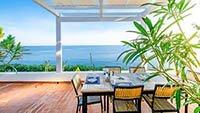
Are you looking for holiday lettings in Sicily but can't see the wood for the trees? We're not surprised, because the range of choices competing online is pretty confusing.
To make it simple, we present a small selection of quality holiday rentals, each one chosen for an unusual feature to make your holiday in Sicily extra special... more
Fashion made in Sicily

Sicilian fashion? Dolce & Gabbana?
Sure! But fashion designed and manufactured in Sicily is the real insider tip.
Like that of the Sicilian designer Filly Cusenza from Bagheria. She creates wearable art made of fabric, thread and buttons. Her trademark and label name is the fancy cartoon girl Filly Biz... more
The Essence of Sicily

Sightseeing Tour of Corleone
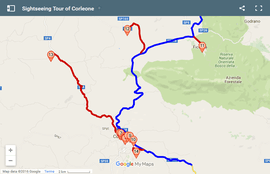
- Access via SS118
- Accessing the parking lot in the city center
- Accessing the parking lot close to the waterfall
- Roads leading to some sidetrips
- Parking lot
- City park - entrance
- Tourist information
- Piazza Nascè
- Piazza Garibaldi
- Mafia Museum
- Old Hospital
- Bottega della Legalità
- Waterfall - parking lot
- Waterfall
- Ficuzza Nature Reserve
- Madonna di Tagliavia Pilgrimage Church
- Borgo Schirò - Mussolini's ghost town
- The hideout of the last Godfather
Reaching Corleone by car
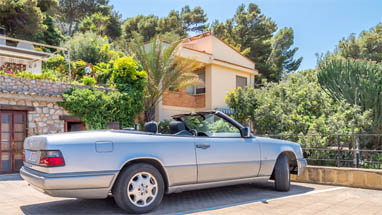
Corleone is located on Strada Statale 118 (the blue line on the map above). SS118 splits off from the highway connecting Palermo and Agrigento (SS121 / SS189) at Bolognetta. From Palermo, the trip takes only a half-hour to forty-five minutes. Those coming from the south, for example, from Agrigento will drive north using SS118.
If you want to visit Corleone's city center, enter the town from the north by turning into Via Giuseppe Verdi. From there, it is just over 1 km to a small parking lot right next to the city park (Marker 1 on the map above).
If you would like to see Corleone's famous waterfall, turn instead at Via Napoli and drive just 200 m down the street to park at this small parking lot (Marker 9).
City Park
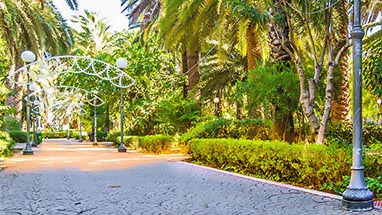 Pin it
Pin it It's only a short walk from the parking lot (Marker 1 on the map) to an amazing sight for this small town of 11,000 people - the Corleone city park (Marker 2). At a whopping 4,000 square meters this splendid spacious reserve is something like the "Central Park" of the city.
Unlike New York City though, Corleone doesn't need this park in order to breathe. The village has been a center of Sicilian agricultural life since at least the arrival of the Arabs in the 9th century. A quick look at the satellite view of the map above shows that this is true even today.
Corleone is also just 10 km from the vast Bosco di Ficuzza nature reserve. But that protected environment only complements and does not replace the wonderful city park. Luckily, you don't have to pick just one: you can visit both during your holiday in Sicily. For new visitors, Corleone's city park is an excellent introduction to the city. You can find both relaxation and information there: at the entrance is the Tourist Information center (Marker 3 on the map).
Piazza Nascè
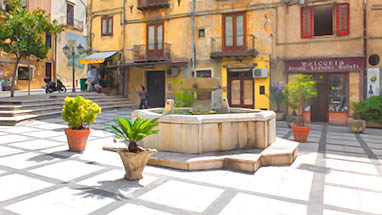 Pin it
Pin it On the way to Corleone's city center, visitors will discover the central square - Piazza Nasce (Marker 4 on the map above), named after Francesco Paolo Nasce, a literary figure born in Corleone in the 18th century.
Outside of Sicily, Nascè is known only to academics. No wonder - his focus was the modernization of Sicilian literature, which he pursued while a professor at the University of Palermo.
Much better known, though, is the city square named after him, which exists today as a symbol of the old Sicilian feudalist system. In earlier times, Piazza Nascè marked the border between the city and the surrounding fields of the land barons. Their managers (the gabellotti) hired laborers every morning in this square to work in the fields.
And there were armies of these landless peasants right up to the end of the Second World War when land reform gave them their own small farms. As result, today in the early mornings you will find in the piazza neither landless peasants nor mafia gabellotti anymore.
Piazza Garibaldi
 Pin it
Pin it From the city park we head straight to Piazza Garibaldi - the center of old Corleone (Marker 5 on the map above). And as we find as almost in every Sicilian village, we find in this square the town hall, the town's largest church, and of course a cafe.
This cafe in the town center cheekily uses the mafia on its advertisement: on the outside wall, next to the entrance, there's a large picture of a scene from "The Godfather" - but of course not just any scene.
The picture shows a young Michael Corleone (Al Pacino) on his first visit to Sicily, very properly attired with a sawed-off shotgun on his back - as in the video at the start of this article. The cafe-owner has a knack for marketing. He presents exactly that what some Sicily holidaygoers expect to see in Corleone.
Actually, though, the movie was not even filmed in Corleone. And today at the Town Hall at Piazza Garibaldi, the city council meets – the same city council that back in 2012 officially apologised for Corleone's real mafia past.
Mafia Museum
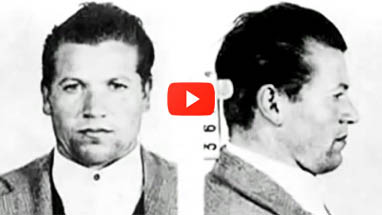
As one can see even in Piazza Garibaldi, the word "mafia" today means two things in Corleone: the first is a media stereotype meant to appeal to tourists; the second, the ongoing process of coming to terms with a real-life mafia past.
The latter is the reason behind the Mafia Museum just a few meters away from Piazza Garibaldi (Marker 6 on the map above). The museum has two parts. The first is a presentation about organized crime in general.
The second part is aimed at tourists and has two chief messages. The first message is "Mafia = terror". It features photos of Corleone and Palermo taken mainly in the '70s and '80s. They focus the viewer's attention on the fact that terrorism doesn't just mean events in the Middle East.
The second message takes the form of a huge shelf of old files. These date from the so-called Maxi Trial, the first major application of the rule of law upon the mafia in the first half of the 1980s. Thanks to that effort, nearly 400 mafiosi ended up in high-security prisons. The message from this part of the exhibit is clear: the Mafia can be successfully combated and defeated using legal and just methods.
Of course, whoever would rather enjoy their well-deserved holiday in Sicily without dark stories of old misdeeds can stroll right past the Mafia Museum and just absorb the peaceful little town of Corleone.
- Opening times and admission prices of the Mafia museum.
- TripAdvisor reviews of the Mafia museum.
The Old Hospital
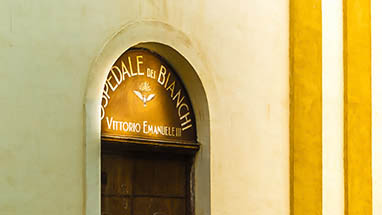 Pin it
Pin it Just a few meters from the Mafia Museum you will find the one-time hospital in Corleone (Marker 7 in the map above). It is being remodeled into a cultural center. Usually hospitals are not important stops while on holiday, especially in Sicily. But this location has a real local importance - one linked to the Corleone's Mafia past.
The old hospital's notoriety goes back to a popular doctor in Corleone. As prominent as Dr. Michele Navarra was as a local physician, he was positively brutal when it came to advancing his own ambitions. His career made a great leap forward when he became chief of the hospital – a position he got in 1946 by murdering his predecessor.
The hospital became a veritable hotbed of mafia intrigue. Even during the recent renovation, hidden weapons were still being found in the hospital's walls. The man responsible for such a climate of violence in the end found it turned back on himself. In 1958, Michele Navarra was assassinated by rivals.
Navarra's murder marked the start of the careers of two young Mafiosi who helped turn the Sicilian mafia into an international franchise: Salvatore (Totò) Riina and Bernardo Provenzano. Two names that have become linked to the image of Sicily in the world - unfortunately, not in a positive way.
Bottega della Legalità
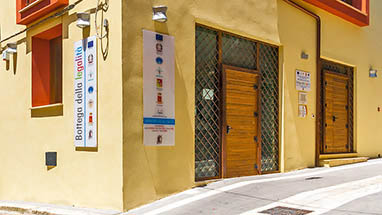 Pin it
Pin it In 1993 and 2006, the Italian prison system "adopted" two famous gentlemen: Totò Riina and Bernardo Provenzano. Both have now passed 80 and will spend their final days in a maximum security prison.
In addition to the standard method of prosecution, the Sicilian legal system currently uses a second very powerful weapon: the confiscation of mafia property. With this measure, any remaining mafia operations lose their economic strength and viability. Expropriated property is handed over mostly to a varietyof anti-mafia initiatives.
Probably the best known is the "Libera" initiative founded by the rather secular priest Luigi Ciotti in 1995. Involves several fields and vineyards between Palermo and Corleone. The products of these properties are sold under the brand Libera Terra (Free Earth) all across Europe.
Corleone also has its own "outlet" - the Bottega della legalità (Marker 8 in the map above). In English its name "Shop of Legality" may sound a little bit weird, but the name indicates that the building was confiscated - in fact, from none other than the famous Bernardo Provenzano. If you buy a bottle of wine here, it is certified that the entire supply chain was mafia-free. In this way, while on holiday in Sicily you can also help the anti-Mafia movement in Corleone.
The waterfall
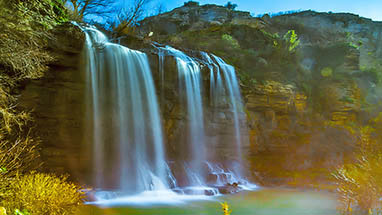 Pin it
Pin it We started with the natural side of Corleone and want to end with it: on the eastern side of the city and a mountain - the "Montagna Vecchia" (Old Mountain)..
Like so many mountains of Sicily the "Montagna Vecchia" accumulates a lot of surface water in the wintertime. And since this mountain falls steeply on the side facing the city, the water falls there, too (Marker 10 in the map above).
In the old days, the waterfall was used to generate power for a flour mill. It was a very thoughtful solution in an era of traditional agriculture. Corleone was able to produce not only grain, but also flour.
Grain is still grown in the fields of Corleone today. But the waterfall is now used for a different industry - tourism. It is actually a pretty impressive holiday experience and one of the many reasons to visit Sicily in winter.
Ficuzza Nature Reserve
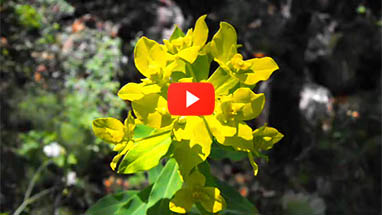
Driving from Palermo to Corleone you will pass through what is perhaps the most beautiful nature reserve in Sicily - the "Riserva Naturale Orientata Bosco della Ficuzza, Rocca Busambra, Bosco del Cappelliere e Gorgo del Drago" (Marker 11 in the map above). No – the name couldn't be any shorter! For simplicity's sake, let's just call it "Ficuzza" - after the village in the middle of the reserve.
The huge hunting lodge in the village shows that it isn't only today's holidaygoers who are thrilled by Ficuzza. It was built in the late 18th century by no less than the King of Sicily. And he wouldn't have put such a retreat into just any forest. The site was specially chosen because here the gentle ebb and flow of forest landscape is just right – perfect for the King and perfect for those on holiday in the present day. Not too steep (or too tiring) but not too flat (and boring).
That's why Ficuzza is perfect for Sicily vacationers who want to wander around in a bit of Nature without doing a lot of heavy mountaineering. Although Ficuzza does have something to offer those who want to go higher: the Rocca Busambra. To climb this 1600m high cliff, hiking poles and hiking boots – and no fear of heights – are all essential.
And if the Rocca Busambra is still not wild or challenging enough, you can join the mountain-climbing group Sicilian Alpine Club and tumble down the waterfall "Gola del Drago". For this special treat, however, you have to visit Sicily in winter or early spring.
Madonna di Tagliavia Pilgrimage Church
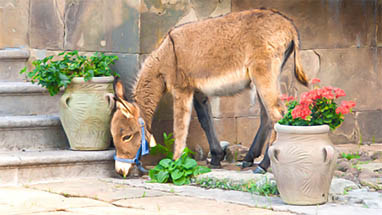 Pin it
Pin it On the way from Ficuzza to Corleone, a small detour into the "boondocks" is worthwhile. Because at Marker 12 in the map above, you will find yourself suddenly in front of a rather unique and lovely little.
It is not surrounded by a village as you might expect. No, it's just fields and meadows as far as the eye can see. So how in heaven's name did this church get there?
In the old days the surrounding area was part of the "Strasatto" fief. Around 1800 it was leased to a rancher named Lo Jacono. One day, Lo Jacono instructed his sons to build a holding pen for sheep on the site.
The sons went to work and began collecting building material. In the process, the sons found a large square stone bearing the image of St. Mary of the Holy Rosary. They built a foundation, preserved the stone with the image on it and began to build a fence around the whole thing. And suddenly a spring opened up with the purest water - in a previously completely dry environment.
But that's not the whole story: as it soon turned out, the water was not only clean, but also conferred health benefits. It saved a flock of sheep that had been afflicted with disease. The King residing in the hunting lodge of Ficuzza heard about it. Being tortured by a knee ailment he went to the source, prayed, drank some water, got up and went away healed. In gratitude, he signed 20 hectares of land over to the new sanctuary – under the jurisdiction of the Roman Catholic Archdiocese of Monreale.
The King also promised to sign over the remains of a fief called "Tagliavia" to the sanctuary - provided that he received certain political concessions. He got his wish, and the sanctuary got another 60 hectares of land. At the same time the King pushed for the construction of a church. Years later, on May 1, 1845, the pilgrimage church "Santuario Madonna di Tagliavia" was dedicated.
You may believe the beginning of the story or not. That the King signed over about 80 hectares of land to the Roman Catholic Archdiocese of Monreale is, however, an established fact. Further, a pilgrimage church was clearly built, as you can see and enjoy with your own eyes.
In the old days, this church was maintained by monks who lived in an annex of the church. Today this task has taken over by the Community Five stones. Nuns are now also "allowed" – as in modern times with the Catholic Church. The "Five Stones" refers among other things to St. Francis of Assisi, the patron saint of animals. So if you encounter dogs and donkeys on the church steps, that's no coincidence.
Borgo Schirò - Mussolini's ghost town
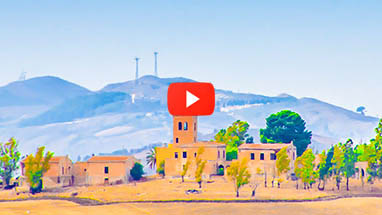
Finally back from your trip to Corleone you decide to end the day with a nice pasta alla carbonara.
But what are the origins of the dish?
Ideally, of course, you brought the ingredients from the Bottega della Legalità in Corleone. But your pasta was not grown on the shelves of the Bottega. No, ultimately, agriculture gives us everything on our plate.
But Sicilian agriculture has brought many things including the Mafia. As feudalism slowly disappeared in the West starting in the 18th century, Sicilian land barons tenaciously struggled to maintain it. Worse, they sometimes left their fields to overseers (the gabellotti) - in the truest sense of the word. These had zero interest in modernizing agriculture. No wonder - there was an army of landless peasants to consider.
The struggle to maintain the old system was fierce and often violent. To achieve their ends, the gabellotti hired field guards (the "Campieri"). Their corporate uniform: flat cap and lupara (sawn-off shotgun).
Someone who wanted finally to put an end to the conflict was - you might not have guessed - Mussolini. Not because he was a good soul. On the contrary: criminals do not often tolerate other criminals working right beside them; and further, Mussolini needed food for his forays into Africa.
To achieve the objective, he appointed the "Iron Prefect" Cesare Mori. The first goal was the transfer of ownership of unused land to landless peasants. New villages were sometimes built just for them. One of these villages, Borgo Schirò (Marker 13 in the map above), is located just outside Corleone.
As we now know, Mussolini's policies and activities were not particularly "sustainable". When Mussolini was gone, the Mafia recovered very quickly from the blows of Cesare Mori and the Mussolini villages became ghost towns. The video above shows the current state in Borgo Schirò very nicely - even if it has been edited in the beginning to look a little gloomy. A visit to this very special site in the struggle of the anti-Mafia movement is memorable in any case.
The Last Godfather
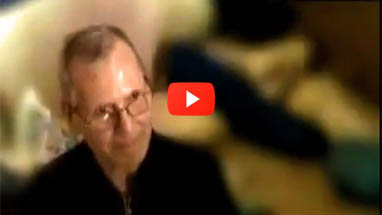
As we saw in the previous section, Mussolini's fight against the Mafia had little long-term success. Indeed, after the Second World War was over, Corleone quickly became the new stronghold of the Sicilian Mafia.
The "bosses of bosses" from the 1960s on were all "Corleonesi". They lorded over Mafia families of Palermo with brutality and wanton - and so dug their own graves.
While in the old days the Mafia was dismissed as folklore, with all the increased violence the Italian government was forced to act. The Mafia responded with attacks on police officers, prosecutors and judges - and forced the government's hand even more: in the early 1990s even the Italian army was used.
Meanwhile, a policy of leniency for informants and witness protection programs were set up. They were an escape for mobsters who themselves suffered from the orgies of violence. These pentiti were probably the most important leverage used by those hunting the Mafia: with each new informant, the formerly secret "Cosa Nostra" organization became more and more transparent. Long one of the most important codes of the Mafia, the Omertà, was no longer working.
The friendly older gentleman in the picture above recognized this. His name is Bernardo Provenzano, the last "boss of bosses" of Corleone. If you run the video, you will see his arrest on April 11, 2006. But do not feel sorry for him: before he finally realized that the Mafia had damaged itself with all the violent excess, he himself was deeply involved in the violence. As result, he is spending the rest of his wasted life in a high security prison for commiting multiple murder.
If you should decide to visit the place of his arrest (Marker 14 in the map above) - be warned: it's a deadly dull place. You will see only the summer house with attached sheep pen seen as in the video above. And this was the place where the "boss of bosses" and multimillionaire Bernardo Provenzano lived. Hard to believe! Although unfortunately for him, the gentleman is no longer a millionaire - his property was confiscated.
How Don Vito Corleone got his name
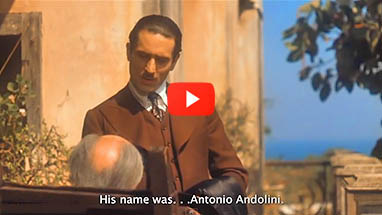
Don Vito Corleone - it is no coincidence that Mario Puzo gave the central character of his novel this name.
Of course, Puzo did extensive research for his novel. That is shown first of all by the choice of the name "Corleone". At the time, in the 1960s, the city was considered to be one of the strongholds of the Mafia (which contrary to previous official denials actually existed).
So it made sense to call a Mafia family "Corleone". In the town of Corleone itself this last name does not exist, however. Mario Puzo therefore invented a special history. In the film The Godfather Part II, it went like this:
Back in 1901 a certain Antonio Andolini dared to behave disrespectfully to the Mafia boss of Corleone, Don Ciccio. He paid with his life. Antonio's son Paolo swore revenge and was shot by Don Ciccio as a "precautionary measure" during the funeral of his father.
Antonio's widow then visited Don Ciccio, and asked him at least to spare the youngest son, Vito. Don Ciccio refused. The mother now had only one option: she put a knife to the throat of a sitting Don Ciccio and thus gave her son Vito precious moments to escape. Don Ciccio's henchmen succeeded in overpowering the mother, and shot her, too.
Little Vito with the help of relatives escaped on an emigrant ship to America. Arriving at Ellis Island, an officer mixed up his town of origin and his last name, and so Vito Andolini became Vito Corleone.
In fact, Don Ciccio should have put more effort into murdering little Vito. The video shows why: Vito Corleone (grown up and played by Robert De Niro) returns to Sicily and seeks out the now old and deaf Don Ciccio.
Even if you don't speak Italian, you will be sure to understand the rest of the story - dead sure.
Now, you may wonder: does "The Godfather" embellish with its excessive cruelty? Unfortunately not. While the characters are not authentic, the storyline is. The real godfathers of Corleone wiped out entire families to retaliate - or to protect themselves from revenge. And they also did not stop when it came to children.
Indeed, the reality was often crueler than fiction. Some therefore accuse the film not of too much violence, but of romanticizing the facts.